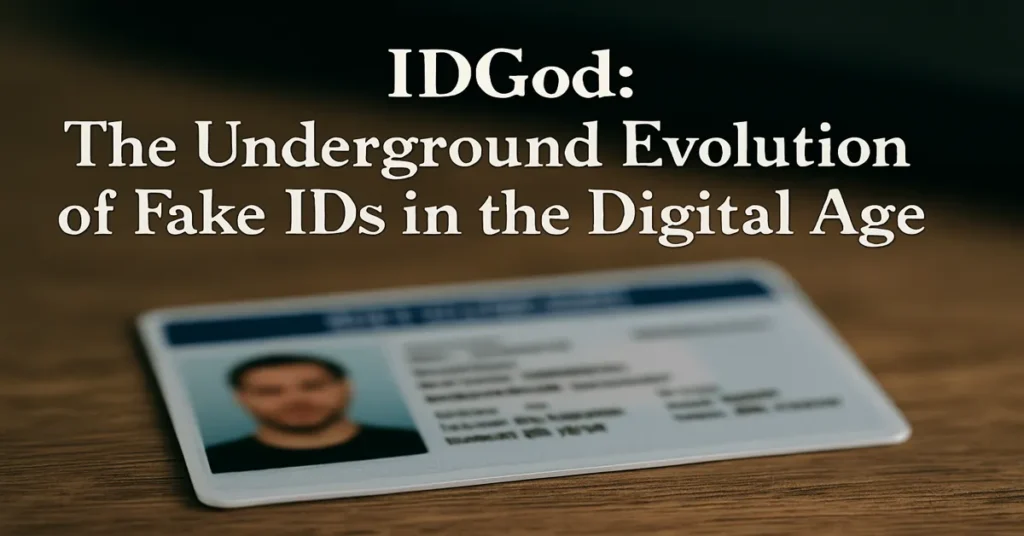In the background of every college town, neon-lit bar strip, and fraternity house party, a quiet phenomenon pulses: the circulation of fake IDs.
Among the many underground brands whispered about in dorm rooms and online forums, one name has achieved near-legendary status: IDGod.
Originally surfacing decades ago, IDGod has become synonymous with the world of high-quality counterfeit identification, even as technology, law enforcement, and social norms have shifted dramatically.
Today, the story of IDGod is not just about underage drinking or youthful rebellion. It’s a lens on cybersecurity vulnerabilities, the ethics of digital anonymity, and the blurry line between risk and rite of passage in modern youth culture.
This is the evolving story of IDGod — a phenomenon at the crossroads of legality, innovation, and identity itself.
The Origins of IDGod: A Ghost in the Machine
The earliest traces of “IDGod” date back to the late 1990s and early 2000s, when the internet was still an emerging frontier.
Early websites, often operating on the fringes of the web, began offering fake driver’s licenses designed to mimic those issued by U.S. states.
Unlike cheap paper laminations of the 1980s, these new IDs were convincing:
- Holographic overlays
- Scannable barcodes
- Magnetic strips mimicking state databases
IDGod quickly distinguished itself as one of the most reliable and discreet sources — gaining reputation through word-of-mouth among college students, nightlife denizens, and the curious.
It’s worth noting: IDGod was never a single entity. Over the years, the “brand” has been adopted, abandoned, hijacked, and reimagined by various operators, primarily based offshore.
How the Fake ID Business Evolved
Initially, ordering a fake ID was a clumsy, risky affair involving sketchy email chains, money orders, and long waits.
Today, thanks to encrypted messaging apps, cryptocurrency, and globalized shipping networks, the process can seem almost frictionless.
Modern Evolution Includes:
- Sophisticated Websites:
Professional layouts, shopping carts, customer service chatbots. - Cryptocurrency Payments:
Bitcoin and other coins allow semi-anonymous transactions. - Group Discounts:
Encouraging bulk orders for fraternities, sports teams, or social circles. - Tracking Numbers:
Buyers can track shipments via legitimate courier services, sometimes cleverly disguised as harmless goods. - Template Precision:
Modern fake IDs replicate even minor details like microtext, UV-reactive features, and raised fonts.
The digitalization of black-market commerce has made fake IDs more accessible, cheaper, and harder to detect.
The Risks: Legal, Financial, and Ethical
For all its accessibility, interacting with IDGod or similar services carries serious risks — risks many young users fail to fully appreciate.
Legal Risks
Possessing or using a fake ID is a crime in most jurisdictions. Consequences can include:
- Fines:
From a few hundred to several thousand dollars. - Misdemeanor Charges:
Leading to probation, mandatory classes, or community service. - Felony Charges:
In cases involving identity theft, multiple offenses, or intent to defraud. - College Disciplinary Action:
University codes of conduct often impose suspension or expulsion for criminal behavior.
Notably, penalties can be even more severe for producing or selling fake IDs — especially across state or national lines.
Financial Risks
Ordering from IDGod often involves wiring untraceable cryptocurrency to unknown entities overseas. Scams are rampant:
- No ID Delivered:
Scammers take the money and vanish. - Low-Quality Products:
IDs that fail under minimal scrutiny, leading to immediate confiscation. - Data Theft:
Personal information (including real name, address, birthdate) could be harvested for identity theft.
Ethical Risks
Beyond legal and financial dangers lies an ethical gray zone.
At its core, a fake ID is a lie — an attempt to misrepresent identity for personal gain.
This may seem trivial when buying beer, but the implications are more serious when considered broadly:
- Desensitization to fraud
- Normalization of deception
- Compromising security systems designed to protect public safety
For a generation grappling with issues like misinformation and digital trust, the casual normalization of fake IDs carries deeper cultural ramifications.
How Law Enforcement Fights Back
Authorities are not unaware of IDGod and similar operators.
Common Tactics Include:
- Undercover Operations:
Officers pose as buyers to identify vendors. - Customs Intercepts:
Shipments containing fake IDs are seized at ports of entry. - University Partnerships:
Many colleges now collaborate with local police to crack down on fake ID use during school events. - Data Sharing:
International law enforcement agencies increasingly cooperate on cybercrime, including the production of false identification documents.
Despite these efforts, the cat-and-mouse game continues — fueled by ever-improving technology on both sides.
The Role of Technology: A Double-Edged Sword
Technology fuels both the creation and detection of fake IDs.
On the Creator Side:
- Laser Engraving:
For perfect replication of government-issued ID card textures. - Advanced Printers:
Capable of producing holographic layers indistinguishable from authentic ones. - Barcode and Magnetic Encoding:
Allowing fake IDs to scan properly at point-of-sale systems.
On the Enforcer Side:
- ID Scanners:
More bars and clubs are using handheld devices that validate IDs against real databases. - Blockchain Authentication:
Emerging government programs propose blockchain-secured IDs that would be virtually impossible to forge. - Facial Recognition:
Systems compare real-time customer faces with government ID photos at points of entry.
Technology, in short, has raised the stakes on both sides — making the battlefield more sophisticated and more perilous.
The Cultural Side of Fake IDs
The fake ID has long held a romantic place in American popular culture.
From movies like Superbad (with its now-infamous “McLovin” ID) to the whispered legends of that one senior who “knew a guy,” fake IDs are woven into the tapestry of youth rebellion.
At their core, fake IDs symbolize:
- Freedom:
The ability to bypass age restrictions and participate in adult spaces. - Status:
Possessing a convincing fake ID can enhance social clout among peers. - Adventure:
The thrill of “getting away with it” forms a rite of passage for many.
But today, the stakes are arguably higher.
In a hyperconnected world, where consequences can be instant and permanent (thanks to social media and digital records), what once seemed a mischievous act carries heavier potential fallout.
IDGod Today: Myth or Market?
Is there a single IDGod operating today?
The answer is complicated.
The original operators likely disbanded, fled, or were arrested long ago.
However, the “IDGod” brand persists — co-opted by various new vendors who leverage its legacy reputation to attract customers.
Some “IDGod” websites today are reputable (within the black-market definition); others are elaborate scams.
For young buyers, distinguishing between them is perilously difficult — a risky game in an already dangerous arena.
Safer Alternatives for Youth Expression
Many of the reasons young people seek fake IDs — freedom, exploration, social acceptance — are real and valid.
But alternatives exist:
- All-Ages Venues:
Increasingly, bars and music festivals host 18+ nights without alcohol sales. - Community Events:
Outdoor movie nights, open mic sessions, and art galleries provide social spaces without age barriers. - Early Professional Networks:
Building adult connections through internships, volunteering, and online learning communities fosters real maturity.
These options lack the illicit thrill of a fake ID — but offer growth without the corresponding legal jeopardy.
The Future of Fake IDs
As digital identity verification strengthens, the days of traditional fake IDs may be numbered.
Already, experimental technologies hint at seismic shifts:
- Mobile Driver’s Licenses (mDLs):
Digital versions of IDs stored on smartphones with biometric protection. - Self-Sovereign Identity (SSI):
Blockchain-secured identities owned and controlled directly by individuals. - Biometric Access Controls:
Venues moving toward facial recognition or fingerprint scanning for entry.
In such a future, the idea of forging a plastic card would seem quaint — even absurd.
But as history shows, whenever barriers arise, humans find ways to circumvent them.
The desire for agency, rebellion, and boundary-pushing — embodied by IDGod and its kin — will likely never disappear.
Only the methods will evolve.
Conclusion: IDGod as a Cultural Artifact
IDGod is more than a name.
It is a mirror — reflecting youthful ambition, societal restriction, technological ingenuity, and moral ambiguity.
It speaks to a generation raised in a world of paradox:
- Told to wait, but expected to act maturely.
- Surrounded by adult experiences, but barred from participating.
- Connected globally, but confined locally by laws and norms.
In this tension, the fake ID thrives — not simply as a ticket to underage drinking, but as a symbol of the broader human desire to accelerate into adulthood.
As technology, law, and culture continue to evolve, so too will the dance between restriction and rebellion.
And somewhere, in the encrypted corridors of the internet, a new generation of IDGods will rise — chasing the same old dream with new tools, new risks, and new stories to tell.







